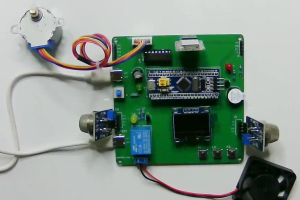设计说明书
总字数:16000+
本文旨在设计与实现一种基于STM32F103C8T6单片机的智能厨房安全监控系统。该系统集成了MQ-5和MQ-2气体传感器、电磁阀门(步进电机模拟)、声光报警器、通风装置、OLED显示屏和WIFI模块。通过MQ-5检测可燃气体浓度,一旦浓度超过设置最大值,系统将自动关闭电磁阀门,触发声光报警器和通风装置,并发送警报信息到手机端。同时,通过MQ-2检测烟雾浓度,一旦检测到火灾,系统会触发声光报警器和发送火灾警报信息到手机端。通过OLED显示屏显示监测数据,用户可以通过按键设置各阈值。此外,WIFI模块使得用户可以通过手机端远程获取实时监测数据,并可以对系统进行远程控制,包括设置阈值、开关电磁阀门和风扇等功能。本文设计与实现了一种智能厨房安全监控系统,提高了厨房安全性,有效预防可燃气体泄露和火灾事件,为用户提供了便捷的监控和控制方式。
关键词:智能厨房安全监控系统;MQ-5;MQ-2;远程测控;通风装置
This paper aims to design and implement an intelligent kitchen safety monitoring system based on the STM32F103C8T6 microcontroller. The system integrates MQ-5 and MQ-2 gas sensors, an electromagnetic valve (simulating a stepper motor), a sound and light alarm, a ventilation device, an OLED display, and a WIFI module. By using the MQ-5 gas sensor, the system detects the concentration of combustible gas. If the concentration exceeds the set maximum value, the system automatically closes the electromagnetic valve, triggers the sound and light alarm, activates the ventilation device, and sends an alert message to the user’s mobile phone. Additionally, the system utilizes the MQ-2 sensor to detect smoke concentration. In case of a fire, the system activates the sound and light alarm and sends a fire alarm message to the user’s mobile phone. The monitoring data is displayed on the OLED screen, and users can set various thresholds through buttons. Moreover, the WIFI module enables users to remotely access real-time monitoring data on their mobile phones and control the system remotely, including setting thresholds, switching the electromagnetic valve and fan, and other functions. This paper designs and implements an intelligent kitchen safety monitoring system, which enhances kitchen safety, effectively prevents combustible gas leaks and fire incidents, and provides users with a convenient monitoring and control approach.
Keywords: Intelligent kitchen safety monitoring system; STM32F103C8T6; MQ-5; MQ-2; Remote monitoring and control; Ventilation device.
目 录
智能厨房安全监控系统
摘 要
ABSTRACT
1 绪论
1.1 选题背景及实际意义
1.2 国内外发展历程
1.3 研究目的
2 系统设计方案
2.1 主要元器件选择
2.1.1 主控芯片选择
2.1.2 烟雾检测模块方案选择
2.1.3 可燃气体检测模块方案选择
2.2 整体设计方案
3 硬件设计
3.1 主控电路模块
3.2 烟雾检测电路模块
3.3 可燃气检测电路模块
3.4 显示电路模块
3.5 步进电机电路模块
3.6 独立按键电路模块
3.7 报警电路模块
3.8 继电器电路模块
3.9 物联网电路模块
4 系统程序设计
4.1 编程软件介绍
4.2 系统主流程设计
4.3 步进电机子流程
4.4 OLED显示流程设计
4.5 WiFi流程设计
5 实物制作与调试过程
5.1 电路焊接总图
5.2 烟雾检测功能测试
5.3 可燃气体检测实物测试
6 结论和未来展望
致 谢
参考文献
附录A:原理图
附录B: PCB
附录C:主程序
购买后可查看具体内容!

